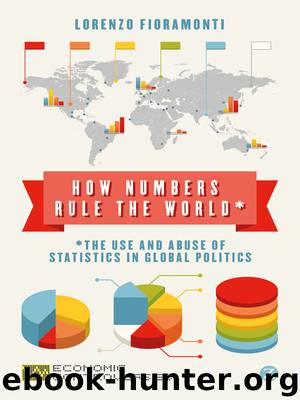How Numbers Rule the World by Lorenzo Fioramonti

Author:Lorenzo Fioramonti
Language: eng
Format: epub
Publisher: Zed Books
Published: 2013-03-19T16:00:00+00:00
CHAPTER 5
Numbers for good? The quest for aid effectiveness and social impact
Not everything that counts can be counted. And not everything that can be counted counts.
Albert Einstein
The strength of ‘development’ discourse comes of its power to seduce, in every sense of the term: to charm, to please, to fascinate, to set dreaming, but also to abuse, to turn away from the truth, to deceive.
Gilbert Rist, The History of Development: From Western Origins to Global Faith, 1997
Measurements help us gauge if and to what extent we are achieving intended results. Doctors rely on numbers to monitor the effects of medical treatments on patients, engineers develop numbers to assess the stability of buildings, and mechanics use them to measure the amounts of water, oil and fuel that go into a vehicle. As we have seen, while numbers do not possess any intrinsic normative value, their power is derived from the capacity to reduce complexity to a few observable facts. This is why, when numerical reasoning is systematically applied to the world of human interactions, it can lead to all sorts of aberrations. In no field is this as evident as in the policies of development cooperation and social change, where statistical measurements have become the cornerstones to design and evaluate programmes and projects across the world. The international debate on aid effectiveness is fundamentally trapped in a global quest to produce quantitative indicators of all sorts to show that development policies work. In the field of social change, impact evaluations are largely dominated by econometric models, in which the complexity of social relations is lost through the cracks of mathematical algorithms. As is the case with climate change and natural capital accounting, these new measurements of success have paved the way to a transfer of technical tools from the business sector to the world of philanthropy and the nonprofit. Concepts such as social investment ratings, social return on investment, cost-effectiveness and standardized assessments have become particularly popular in a sector traditionally characterized by qualitative analyses, long-term horizons and social engagement.
As a young and inexperienced academic, I lived through this change myself. In the mid-2000s I got invited to advise one of the largest development organizations in Europe, whose name (for obvious reasons) shall not be mentioned. At that time I was consulting for NGOs and governments on how to construct social indicators and develop participatory evaluation tools. I remember that it was a beautiful day in September and my client boasted an impressive multi-storey office, whose main entrance opened onto a touristy street, right in the middle of town, in an area where most international development agencies had their headquarters. With pictures of needy African children, natural disasters and melting ice caps on the wall, the building’s hall really made one feel as if that was the place where all the problems of the world were coming together to be tackled at once. It was a powerful albeit depressing vision.
They had invited me to help them improve their impact assessment tools. I
Download
This site does not store any files on its server. We only index and link to content provided by other sites. Please contact the content providers to delete copyright contents if any and email us, we'll remove relevant links or contents immediately.
| Biomathematics | Differential Equations |
| Game Theory | Graph Theory |
| Linear Programming | Probability & Statistics |
| Statistics | Stochastic Modeling |
| Vector Analysis |
Weapons of Math Destruction by Cathy O'Neil(5037)
Factfulness: Ten Reasons We're Wrong About the World – and Why Things Are Better Than You Think by Hans Rosling(4022)
Factfulness_Ten Reasons We're Wrong About the World_and Why Things Are Better Than You Think by Hans Rosling(2754)
Descartes' Error by Antonio Damasio(2732)
A Mind For Numbers: How to Excel at Math and Science (Even If You Flunked Algebra) by Barbara Oakley(2691)
TCP IP by Todd Lammle(2640)
Applied Predictive Modeling by Max Kuhn & Kjell Johnson(2479)
Fooled by Randomness: The Hidden Role of Chance in Life and in the Markets by Nassim Nicholas Taleb(2413)
The Book of Numbers by Peter Bentley(2404)
The Tyranny of Metrics by Jerry Z. Muller(2401)
The Great Unknown by Marcus du Sautoy(2186)
Once Upon an Algorithm by Martin Erwig(2149)
Easy Algebra Step-by-Step by Sandra Luna McCune(2117)
Practical Guide To Principal Component Methods in R (Multivariate Analysis Book 2) by Alboukadel Kassambara(2093)
Lady Luck by Kristen Ashley(2073)
Police Exams Prep 2018-2019 by Kaplan Test Prep(2033)
Linear Time-Invariant Systems, Behaviors and Modules by Ulrich Oberst & Martin Scheicher & Ingrid Scheicher(1983)
All Things Reconsidered by Bill Thompson III(1960)
Secrets of Creation, Volume 1: The Mystery of the Prime Numbers by Watkins Matthew(1864)
